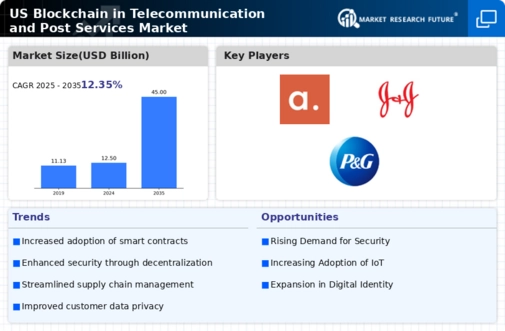Cost Reduction Initiatives
Cost efficiency remains a critical driver in the blockchain telecommunication-post-services market. Companies are actively seeking innovative solutions to reduce operational costs while maintaining service quality. Blockchain technology offers the potential to streamline processes, eliminate intermediaries, and reduce transaction fees. For instance, the implementation of smart contracts can automate various functions, thereby minimizing administrative overhead. In the US, telecommunications firms are projected to save up to $1.5 billion annually through the adoption of blockchain solutions. This focus on cost reduction is likely to enhance the attractiveness of the blockchain telecommunication-post-services market, as businesses strive to remain competitive in a rapidly evolving landscape.
Enhanced Customer Experience
The blockchain telecommunication-post-services market is increasingly focused on enhancing customer experience through innovative solutions. By utilizing blockchain technology, companies can offer personalized services, faster transaction times, and improved data security. This shift is particularly relevant in the US, where consumer expectations are continually rising. A recent survey indicated that 75% of consumers are more likely to engage with businesses that utilize blockchain for secure transactions. As organizations prioritize customer-centric approaches, the blockchain telecommunication-post-services market is expected to grow, driven by the need to meet and exceed customer expectations in a digital-first environment.
Rising Demand for Transparency
The blockchain telecommunication-post-services market is experiencing a notable increase in demand for transparency among consumers and businesses alike. This trend is driven by the need for verifiable and immutable records of transactions, which blockchain technology inherently provides. In the US, organizations are increasingly adopting blockchain solutions to enhance trust and accountability in their operations. According to recent estimates, the market for blockchain technology in telecommunications is projected to reach approximately $7 billion by 2026, reflecting a compound annual growth rate (CAGR) of around 60%. This rising demand for transparency is likely to propel the blockchain telecommunication-post-services market forward, as stakeholders seek to leverage the technology to improve operational efficiencies and customer satisfaction.
Integration with IoT Technologies
The integration of blockchain technology with Internet of Things (IoT) devices is emerging as a significant driver in the blockchain telecommunication-post-services market. This convergence allows for enhanced data sharing, security, and automation across various applications. In the US, the number of connected IoT devices is projected to surpass 30 billion by 2025, creating a vast landscape for blockchain applications. The ability to securely manage and authenticate data from these devices can lead to improved operational efficiencies and new business models. Consequently, the blockchain telecommunication-post-services market is likely to benefit from this integration, as companies seek to harness the potential of IoT in conjunction with blockchain.
Regulatory Compliance and Standards
Regulatory compliance is a crucial driver influencing the blockchain telecommunication-post-services market. As the technology matures, regulatory bodies in the US are increasingly establishing frameworks to govern its use. This regulatory landscape is essential for fostering trust and encouraging adoption among businesses. Companies that proactively align their operations with emerging regulations are likely to gain a competitive edge. For instance, the Federal Communications Commission (FCC) has begun to explore guidelines for blockchain applications in telecommunications. This focus on compliance not only mitigates risks but also enhances the credibility of the blockchain telecommunication-post-services market, potentially attracting more participants and investments.














Leave a Comment